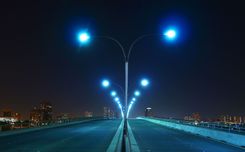The Future of Street Lighting is Smart


Electrical lighting is possibly the single most underrated technological advancement - Those of us living today, or at least most of us, just do not comprehend just how massive electrical lighting was, back when it was invented. Humans as a species are just not anywhere close to effective when our sense of vision is taken out of the equation.
When man freed himself from the gigantic constraint of being tied to the sun’s schedule, practically everything about human life changed over the next century. Today, the entire world, even those parts of it that are hamstrung by abject poverty, have come to take public lighting for granted. Sure they may not be as thoroughly distributed or even continuously powered, but the point is they are an indispensable part of modern human life.
“Hey, I’m not a first grader! Why are you saying all this, Captain Obvious?”. Here’s the thing - not many of us spare much of a thought for the humble streetlight. Chances are, you never really knew that even today, street lighting represents a huge chunk of practically any municipality or local council’s budget - The idea here is to bring our attention to something that nearly everyone of us takes for granted.
When we think “innovation”, “disruption”, “optimisation” - let’s face it - street lights are not what come to our minds. That’s exactly what we’re trying to do through this post. When we talk about making human civilization more sustainable and more efficient, it’s got everything to do with making the things around us a little better. Sure, this may not sound as cool or be as moving as impassioned speeches made in front of famous gatherings about how we’re being irresponsible as a race - But, the only way we actually make a difference is by looking at the little things around us that could be made better and actually finding ways to do that.
To us, if we haven’t said it ad nauseam already, wireless sensing is where it’s at. Wireless sensing remains the best hope we’ve got in being able to design the systems of the future. In a nutshell, the problem wireless sensing aims to solve is this - there are a lot of gaping inefficiencies in the way we’ve organised things around us. That’s all too understandable though - we just made them up on the go and kept doing our best to not let things crash. Wireless sensing and IoT technology make systems less haphazard and more connected, by facilitating a free flow of information all throughout the system. IoT based systems encourage efficiency, minimalism and elegance. Moreover, these systems can progressively get better over time, by implementing incremental improvements based on accrued feedback. What’s not to like huh?
Here, we thought we’d focus on one of these everyday aspects of human life that can be made infinitely more efficient using wireless sensing technology - In this post, we’ll go over some of the most difficult challenges involved in the seemingly mundane enterprise of lighting up our streets - and how IoT, like it does with everything else, is disrupting this space like nobody’s business.
Gee that’s expensive
Let’s take a look at a couple of the big issues with traditional models of street lighting.
Let’s start with the low hanging fruit shall we?
Now it doesn’t take an Einstein to know that lighting up entire cities, throughout nights, every night, must cost serious moolah. After all, there are times when just our personal electricity bill is a bit too steep for our comfort - forget about entire cities, highway systems - well, you get the gist.
So, that brings us to our first major problem with “dumb” street lighting. The traditional model of street lighting is one of the biggest expenditures in any local body’s budget. Hundreds if not thousands of bulbs that are just left to do their business through the long nights. You’d have to agree that this model sounds like it’s pretty wasteful. It doesn’t take a genius to figure out that there’s got to be some way to make this more efficient.
To make matters worse, there’s not that much energy going around to begin with. The math is pretty simple to be fair - Rampant industrial growth + exploding population = energy crisis. If we don’t get our act together, the future might very possibly be dark. Literally dark. Not having enough energy means what energy is available comes at a premium.
“Hey but aren’t smart people working on this? Don’t we have solar powered street lights and stuff?” Well yes and no. Yes, today, there are more instances of renewable energy sources being used, especially in wealthy countries. But no, this doesn’t solve the problem that we highlighted.
First of all, alternative energy sources are not nearly as widespread as most people think. Secondly, they’re VERY expensive - it’s not a coincidence that you don’t hear about how Chad or Somalia just decided to go coal-free from 2030. Thirdly, and possibly most importantly, the problem of inefficiency still remains. Fixing where and how we get the energy is just one part of the riddle - the part where leaving ALL the streetlights on ALL of the time is egregiously wasteful is quite another.
Ecological nightmare
In addition to being very expensive, which is no small problem, regular streetlights are also quite environmentally costly - According to the United Nations, over 68% of the global population will have moved to urban conurbations by the year 2050.
Streetlighting is another major contributor to CO2 emissions - because there are so many of them dotting highways, tunnels etc etc, and traditionally, they are just on through nights, they are a major emissions culprit.
We’ll leave the intricacies and finer details of this for another post. For now, suffice it to say that the way we’ve been lighting up our streets is not just expensive and wasteful, it is also not very ecologically sensible.
Ok, It’s very clear then - there’s a lot that can be improved about the way we light up our public spaces. So, where does wireless sensing fit into all of this? Let’s dive right into the world of connected street lighting.
The internet keeps all of us and our things connected all of the time. Or at least, that’s where things are headed. And streetlights are no exception.
What is a smart streetlight?
The foundational premise for smart streetlights is to optimise electricity consumption. That was the idea behind “smart” streetlights when people first started working on them.
It’s based on a fairly simple idea - what if all the streetlights in a system were connected to each other and could actively exchange information in order to optimise their consumption to match real-time demand?
It took a while for technology to catch up with the idea, but today it would seem we are there. A reputed research firm estimates that there will be over 100 million LED streetlights deployed all over the world in the next couple of years. So, the jury is out - this nutty sounding idea is not only real but is also a winner.
But why though?
Well, for starters, even though such systems are expensive to install, the payoffs are massive - Smart street lighting systems could account for savings of anywhere from 50% to 75% over conventional streetlighting systems.
But believe it or not, this is just the tip of the iceberg. When implemented as part of a larger “smart” network, like a smart city or smart roadway system, there is no telling what connected streetlights could bring to the table - pardon the cliche, but the sky truly is the limit.
Here is a quick list of what these systems could realistically be capable of - air pollution monitoring, traffic regulation, public internet access, surveillance, crime monitoring etc.
The last one is a biggie in fact - There is understandably a huge link between street lighting and incidence of crime - this one’s fairly obvious. Smart streetlighting systems could account for a crazy 10% drop in crime rate, according to Silver Spring Networks.
Real Life Examples
Intelligent public lighting systems are cropping up in major urban areas all over the world. If anything, these early use-cases just corroborate the claims that have been made about these systems for years now.
Chicago leads the way in the use of IoT in street lights. The American city has announced a plan to invest a mammoth $160 million in replacing over 85% of the city’s public lights. The mayor of Chicago expects this investment to pay off very soon, with a projected 50-70% reduction in energy costs.
Los Angeles has already deployed wireless sensors in over 80% of its roadways. These connected light systems boast of LED bulbs and high speed data connectivity, as well as wireless sensors that are capable of identifying gunshots and other instances of violent crime. In the very first year of use, the city council has reported a 63% reduction in energy expenditure. The proof, as they say, seems to be in the pudding.
The battery problem
This brings us to our favourite topic - wireless sensors and batteries are a match made in hell.
And if at all there is a use-case for wireless sensors that seems tailor made to highlight this problem, it is this. Think about it, if you’re going to invest a ridiculous amount of money into installing entire cities’ worth of smart lights, it would make no sense for the hundreds of thousands (if not more) of sensors in these systems to be battery-powered.
Thankfully, there is a better way - energy harvesting. Our very own homegrown superstar, the ONiO.zero, is a batteryless MCU that works on ambient power.
In fact, we’re so excited about ONiO.zero’s potential in the connected lighting arena, that we’ve decided to dedicate a full post to this topic entirely.













